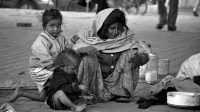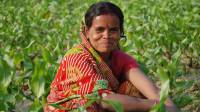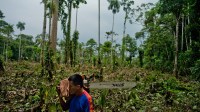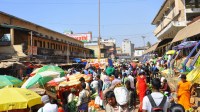Over the past six months I’ve been trying to figure out how we can feed ourselves sustainably and equitably without wrecking the planet. I’ve been reading, interviewing experts, and blogging as I learn. This, the final post of the series, is a synthesis of what I’ve found out.
If the world goes on with business as usual, there’s not going to be enough food to feed everyone by 2050. A lot of things would have to change.
And a lot of things should change! Currently, the daily effort to satisfy the collective appetite of humanity is causing deforestation, erosion, extinction, and massive release of greenhouse gases. In changing how it feeds itself, humankind can drive down poverty, sequester greenhouse gas, conserve wild environments, and put organic matter back into the soil. All of that is plausibly within reach.
Let’s start with population. If we can’t get a handle on our swelling numbers, everything else is moot. So what would make human population level off, or even fall? There are always political measures — like China’s one-child policy — but laws like that are hard to pass and even harder to enforce. They restrict freedom while producing terrible unintended consequences — like families getting rid of girls.
There’s another option that actually works better: Improve the lives of poor women and children.
“If you want parents to make the choice to reduce their number of offspring, there’s no better way than making sure those offspring survive,” said Joel Cohen, author of the magisterial book How Many People Can the Earth Support? “There’s no example of decline in fertility that has not been preceded by a decline in child mortality that I know of.”
This is counterintuitive. But there is abundant evidence of this pattern all over the world, regardless of religion. Where children die and women are repressed, population booms. Where children thrive, and women are empowered, population growth stops.
As sustainable agriculture expert Gordon Conway writes in his book, One Billion Hungry: Can We Feed the World?:
A popular misconception is that providing the developing countries with more food will serve to increase populations; in other words, it is a self-defeating policy. The more food women have, the more children they will have and the greater will be their children’s survival, leading to population growth, so goes the argument. However, the experience of the demographic transition described above suggests the opposite. As people become more prosperous, which includes being better fed and having lower child mortality, the fewer children women want. Providing they then have access to family planning methods, the fertility rates will drop and the population will cease to grow.
To control our impact on the environment, we have to stop growing. A measure of freedom and security for women and children is a precondition to ending population growth. The key factor connecting child mortality and lack of women’s rights is poverty. Therefore, environmental efforts have to be, first and foremost, campaigns for social justice.
If ending all poverty were as simple as producing enough food to feed everyone, our work would be done. Farms already grow enough food for every person on the planet — 2,800 calories a day, if it were divvied up equally. But we have never shared resources equally, and no one seems to have figured out a realistic way of making people start. Attempts by governments to distribute food in equal shares have failed; they almost immediately lead to black markets, with the poor selling food and the rich buying it. An investment banker in New York will always eat better than a beggar in Lagos.
It doesn’t work for governments take complete control of food markets, but it’s also a bad idea for governments to completely wash their hands of responsibility for feeding people. If left entirely to market forces, food flows toward wealth and away from poverty, which leads to famine. Governments must intervene to prevent hunger. Social safety nets — in the form of meals, money, healthcare, and education — really do increase the likelihood that children born into poverty will be able to go to school and make better lives for themselves.
So there’s been a huge shift in thinking from the days of the Green Revolution, when the driving imperative was to increase production. The goal has gone from increasing farm yields to decreasing poverty.
It turns out, however, that if you want to decrease poverty, one of the best ways to do it is to increase farm yields. As the economist Michael Lipton put it: “No country has achieved mass dollar poverty reduction without prior investment in agriculture.”
More than 70 percent of the world’s poor are farmers, or work for farmers in the rural economy. In places where there are no jobs, and the economy sucks, people survive by carving up the land into smaller and smaller plots and working it more intensively. Because of this, typical farm sizes are actually getting smaller in Asia and Sub-Saharan Africa. As of 2000, the average farm was 2.5 acres in Asia and 3.7 acres in Sub-Saharan Africa, not counting South Africa.
Americans like small farms, but this trend toward tiny landholdings in poor countries is not a good thing. When I spoke to a pair of Ethiopian farmers, they told me that what they really wanted was for their children to go to school rather than working on the land and eventually dividing it up. They wanted labor-saving tools — herbicide, plows, planting machines — so that the children could spend time on schoolwork rather than farm work.
In Sub-Saharan Africa, farmers get a little over a ton of grain per hectare in an average year — about what farmers in Europe were getting during the Roman Empire. Clearly there’s tremendous room for improvement, and increasing yields puts money directly into the pockets of the poor. At the same time, it allows their children to go to school and brings down the cost of food — a benefit to both rural and urban poor.
Another argument for increasing yields is that, in the last decade, we got closer to the bottom of the world grain barrel than we have since the 1970s. Economists largely agree that this lack of supply was the primary factor in causing price shocks: The price of food spiked twice, which caused suffering and hunger among the poor.
The final argument for increasing farm productivity is that it will keep people from clearing forests and infiltrating the last remaining wild lands. The world is making progress on this front. Environmental scientist Jesse Ausubel has made a convincing case that we are already past the point of peak farmland. Since 1998 the amount of land devoted to agriculture has fallen, while the global food supply has continued rising. Reducing the human footprint means increasing farm yields.
And yet, despite all the arguments for increasing yields, the goal is controversial, thanks to the legacy of the Green Revolution. During the Green Revolution, the push to increase yields was focused on large farmers, and sometimes smaller farmers did not benefit. There’s a huge amount of conflicting literature on this point. As Conway writes, “A review of over three hundred studies found that for 80 percent of the studies inequality had worsened.” In addition, the heavy use of pesticides and fertilizer during the Green Revolution caused all sorts of environmental problems.
It’s possible to learn from the mistakes of the Green Revolution and strive to increase yields in a way that benefits the poor and is environmentally friendly. The current jargon for this is “sustainable intensification,” which — as happens with jargon — is taken to mean everything and nothing.
Sustainable intensification includes a panoply of agroecological techniques. Farmers are planting nitrogen-fixing trees, which shelter crops, prevent erosion, and provide fertilizer. There’s the push-pull strategy, where farmer push bugs away from grain by growing insect-repellent plants along the rows, while also pulling pests away from the crops by planting an attractive plants outside the fields. Aquaculture is on the rise, creating an opportunity for more fish polyculture. There is significant evidence that these techniques are already providing a part of the solution.
However, I don’t think that they can, or should, be the only solution. In Ghana, farmers trained by 4-H in agroecological techniques abandon them when they actually have to manage their own land and make a living. And an organic farmer training people in Malawi has found that teaching small farmers how to use a little bit of synthetic fertilizer and herbicide is much more likely to work than the all-natural alternatives. As the U.N.’s former special rapporteur on the right to food, Olivier De Schutter, put it, “While investment in organic fertilizing techniques should be a priority, this should not exclude the use of other fertilizers.”
Farmers in poor countries have more important priorities than strictly dividing organic from industrial farm tools. As I put it in this story, farm technology isn’t a war between good and evil — it’s a quest for whatever works. Small farmers have proven that they can use tools of industrial ag in a non-industrial way. They use high-tech hybrid seeds to get record-breaking yields with an alternative cropping technique. Across India, small farmers have found that genetically engineered cotton decreases their pesticide exposure while increasing their earnings. And in Niger, farmers developed a method of using Big Ag fertilizer on a tiny scale: by filling a soda-cap with a mix of phosphorus and nitrogen, and dumping this micro-dose in with each seed.
GMOs, because they are politicized, are especially controversial. I’ve heard the argument that we won’t be able to feed the world without GMOs. I doubt that’s true. Genetic engineering is not a silver bullet. At the same time, the goal of helping small farmers improve their lives gets a lot harder if they are held to an impossibly Edenic standard, and we keep rejecting the tools that they’d like to use.
Many people worry that giving poor farmers industrial technology will lock them into an industrial path. There’s no doubt that is true, as far as it goes. If it’s easy to get nitrogen, you may not want to do all the work, and develop the skills needed, to nurture nitrogen-fixing trees to maturity. But as I’ve argued here, small farmers are already taking a middle path — it’s not as if use of some modern technology will forever corrupt them. When I looked at path-dependency in agriculture, I found that it exists in many small forms, but can be overcome with government assistance and regulation. It’s also worth noting that many small farmers already suffer from path-dependency: They are locked into generational poverty. For me at least, the most important goal is breaking out of poverty, even if that leaves people short of true sustainability. How can I demand perfect sustainability from the poor, when I haven’t achieved it myself?
OK, you’ve reached 2,000 words, it’s time to pause, stretch, regroup, and look at a picture of a baby meerkat.
So far, I’ve argued that the goal is to decrease poverty — that means building social safety nets, and increasing small-farm production. (Because I’m a food and ag guy I’m focusing on farms, but the safety nets are just as important.) I think that increasing yields should be done according to the rule of whatever-works-best, rather than going all natural or all industrial.
And that brings us to solutions: First, what do poor farmers need to make more money? And second, what can those of us living in richer countries do to make food more sustainable and equitable?
Helping poor farmers increase yields
To make more money, farmers need information, inputs, and infrastructure. Information, to learn better techniques; inputs, like fertilizer, disease-resistant seeds, and nitrogen-fixing trees; and infrastructure, which comprises everything from roads and irrigation ditches to agricultural universities.
Governments and charities are spreading information with agricultural advisors. There are also innumerable technological efforts to spread knowledge. I wrote about Plant Village for example. Or there’s Digital Green, which makes videos of farmers carrying out various techniques, and then, in the evening, goes into the village and project the movies. It’s entertainment for the local farmers, and they also learn from someone who speaks their dialect and looks like them.
Inputs and infrastructure go together, because the lack of good roads is the main reason that farmers have trouble getting the supplies they need. Roads also allow farmers to get their crops to market with less spoilage.
Roads are terrible for the environment when built through undeveloped wilderness, but great for the environment when built through poverty-stricken farmland where many people are carving up the land into tiny plots for farms. You need roads to get sustainable intensification — without roads, people keep pushing farther out into marginal lands.
My jaw just about hit the floor when Birtukan Dagnachew Tegegn, a farmer from Ethiopia, told me that there’s no road to her land, and it’s a four-hour walk to the nearest town. Imagine how difficult it is for her to get tree saplings, or a bag of fertilizer, to her farm. A road would save her a lot of time and money.
Conway writes that roadbuilding is a proven intervention:
In India, every additional million rupees spent on rural roads during the 1990s was found to lift 881 people out of poverty. Villages in Bangladesh with better road access had higher levels of input use and agricultural production, greater incomes, and greater wage-earning opportunities.
Roads, canals, and electric systems require government intervention. But small, distributed infrastructure is important too. For instance, when farmers get the machines to process their crops, like the banana farmers of Talamanca, it drastically reduces food waste, while opening up international markets to small farmers.
There’s one other thing beyond information, inputs, and infrastructure that farmers need: money. Farmers all around the world go into debt to buy the things they need to start a new crop, and then pay it off with the harvest. Poor farmers frequently don’t have bank accounts, and take high-interest loans. Banking via mobile phone is solving this problem, and it’s even possible in some places for small farmers to buy affordable crop insurance on their phones.
I’m been making the argument here for some serious government intervention to build infrastructure and train farmers, but it’s also important for governments to help by getting out of the way when farmers want to start businesses serving their growing rural economy. Poor countries tend to have a mind-boggling amount of regulation that hampers homegrown businesses.
What can the people reading this actually do?
A lot, actually. Unless you are the agricultural minister of Kenya or the director of the Rockefeller Foundation, there’s not much you can do with any of the preceding. But people living in richer countries have tremendous influence over multinational corporations that do business, for better or worse, in poor countries. We can also be a lot better at sharing our portion of food, by eating less, wasting less, and choosing more environmentally responsible meals.
There are just a small number of corporations that serve as multinational middlemen — buying crops from farmers in one place and selling them to food makers in another place. Jason Clay, a senior vice president at the World Wildlife Fund, has narrowed it down to 100 businesses — get them to act responsibly, he says, and you save the world. We’re already seeing this working with soy in the Brazilian Amazon, and it’s beginning with palm oil in southeast Asia. The key to getting these companies to commit to sustainability are regular people with reasonable requests, putting strategically targeted pressure on companies. When big companies make sustainability promises, they do a 180 — and instead of resisting regulation, they begin asking governments to regulate their competitors to level the playing field. This really does have the potential to change the world.
The other thing we can do — as I put it here — is to eat with smaller forks. That means changing our diet so that we eat less meat, less food in general, and throw less of it away. There’s also a side benefit: We’ll be healthier. As I wrote:
Right now we live in an upside-down world where the people who get the least food are the ones who are doing the most manual labor. (They’re also the most likely to suffer from infectious disease.) And in the most developed countries, we have technology taking care of all our physical, calorie-burning labor, while we sit on our butts all day and drink everyone else’s milkshake.
All this can seem overwhelmingly large. And it is. The challenge of feeding humanity is enormous and unprecedented. No species, that I know of, has ever organized itself to ensure that every one of its kind is fed. We have the means to meet this demand in the short term, and we are in the process of figuring out how to meet it in the long term. Human welfare depends on our figuring this out. So does the welfare of thousands of other species that live alongside us.
The good news is that, after studying this for six months, I can say that meeting the challenge seems entirely possible. It requires the rich to eat more responsibly, poor farms to become more productive, and all farms to be continuously improving their sustainability. To make this possible, governments must provide safety nets and infrastructure, while cutting red tape.
All this requires a series of political and social changes that are difficult to implement but almost universally supported. No one is morally opposed to reducing food waste, or to increasing the income of small farmers. The most serious impediment is inertia, and we’re already moving in the right direction.
I’ll end with one small, easily achievable suggestion for people who want a well-fed world. (In this piece I also make some recommendations for shrinking forks.) Learn a killer lentils recipe — not just something edible, but something that excites your friends and family as much as steak does. Legumes, like lentils and beans, fertilize the soil and provide a good nutritional replacement for meat, which generally has a big environmental impact. (Though not always — carbon-negative beef exists and is a great alternative.) If everyone replaced one meat dish a week, deliciously, we’d all take a big step toward an equitable and sustainable food system.
Correction: This story included a reference to Zaire as a tossed off example of a developing country. That was a mistake, since the territory previously known as Zaire is now called the Democratic Republic of Congo. Grist regrets the error and the writer has been sentenced to remedial third-grade geography.













